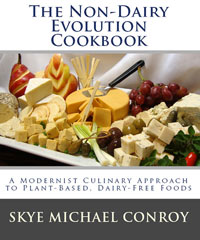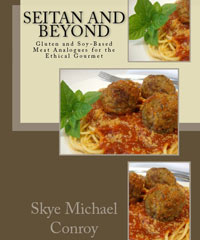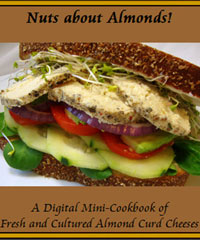Bacun grease is essentially a flavored vegetable shortening. Use for any cooking purpose just as you would real bacon grease; store in an airtight container in the refrigerator and use within 1 year. This recipe yields 1 cup.
Ingredients
• ⅔ cup organic refined coconut oil
• ⅓ cup vegetable oil
• 1 and ½ tsp tamari, soy sauce or Bragg Liquid Aminos™
• 1 tsp dark brown sugar or real maple syrup
• ½ tsp liquid smoke
• ¼ tsp coarse ground black pepper
• ¼ tsp guar gum or xanthan gum (acts as an emulsifier and stabilizer; do not omit!)
Preparation
Melt and measure the coconut oil.
Process all ingredients in a mini-blender or in a heavy measuring cup using an immersion blender until emulsified.
Transfer to a sealable container and freeze until hardened and then transfer to the refrigerator for storage until ready to use.
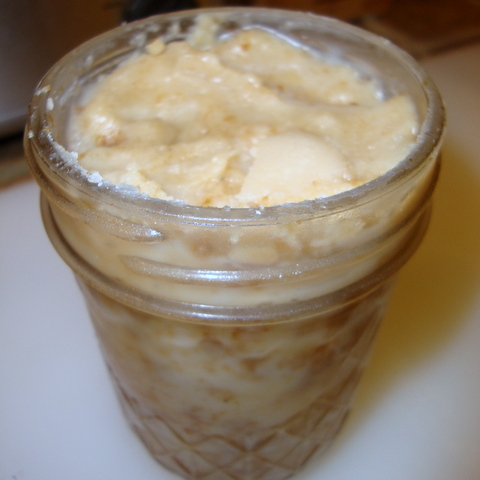
Print Recipe
Bacun Grease
Votes: 30
Rating: 4.13
You:
Rate this recipe!
|
|
Votes: 30
Rating: 4.13
You:
Rate this recipe!
|
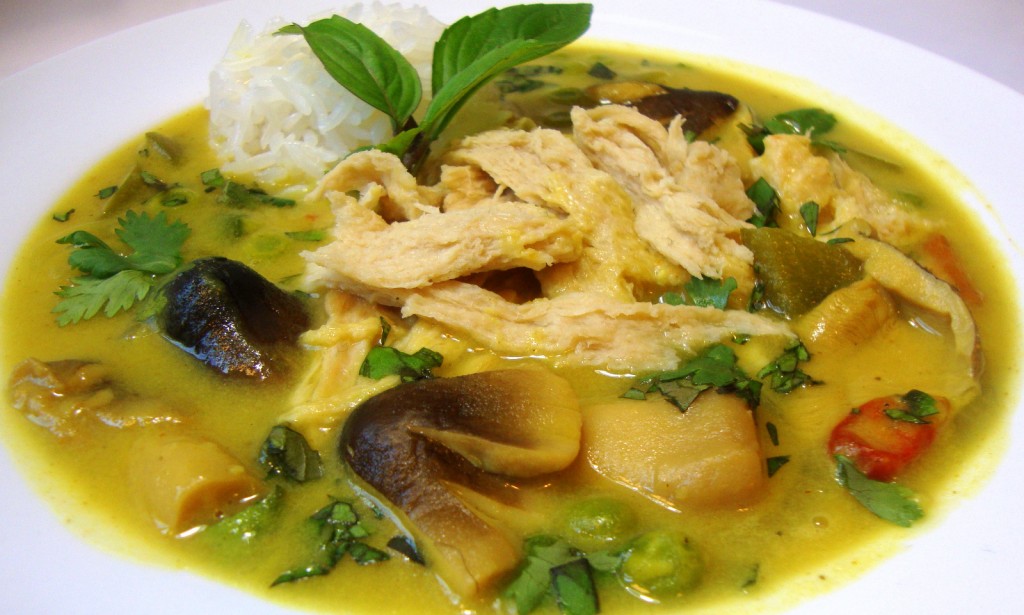 Ingredients
Ingredients
• 4 cups vegan no-chicken broth or similar
• 2 medium russet potatoes, peeled and diced
• 1 T grated ginger
• 3 cloves garlic, chopped
• 4 tsp yellow curry powder
• 1 medium onion, peeled and chopped
• 1 large green bell pepper, chopped
• 1 can (14 oz) coconut milk (full fat; not lite)
• ½ cup green peas, fresh or from frozen
• 1 can (15 oz) straw mushrooms
• 2 tsp sambal oelek (chili paste) or other hot red pepper sauce, or to taste
• a few Thai bird’s eye chilies (optional)
• 1 and ½ cup Stewing Chikun, torn into bite-size pieces; or Shredded Chikun (both from the Seitan and Beyond Cookbook; the Soy Chikun Strips from the same cookbook can be used as substitute if desired; or simply use bite-size cubes of pressed tofu or additional vegetables if you wish to omit the chikun or tofu entirely)
• sea salt or kosher salt, to taste
• chopped Thai basil for garnish (optional)
• chopped cilantro for garnish (optional)
• cooked jasmine rice for serving
Preparation
In a large soup pot, simmer the potatoes, ginger, garlic and curry powder until the potatoes are tender, about 20 minutes. Transfer to a blender and process until smooth (exercise caution when blending hot liquids; place a kitchen towel over the blender lid and begin on low speed progressing slowly to high speed).
Transfer the purée back to the soup pot. Place over medium-low heat and stir in the coconut milk.
Mist a skillet with cooking oil and sauté the onions and bell pepper over medium heat until softened. Add to the soup pot. Stir in the peas, mushrooms, sambal oelek and optional bird’s eye chilies. Cover and simmer about 20 minutes or until the bell pepper is very tender.
Add the Stewing Chikun and simmer an additional 10 minutes; season with salt to taste. If using Shredded Chikun, stir into the curry just before serving. Garnish with the Thai basil and cilantro.
Warning: Do not eat the bird’s eye chilies!
Print Recipe
Thai Yellow Chikun Curry
Votes: 0
Rating: 0
You:
Rate this recipe!
|
|
Votes: 0
Rating: 0
You:
Rate this recipe!
|
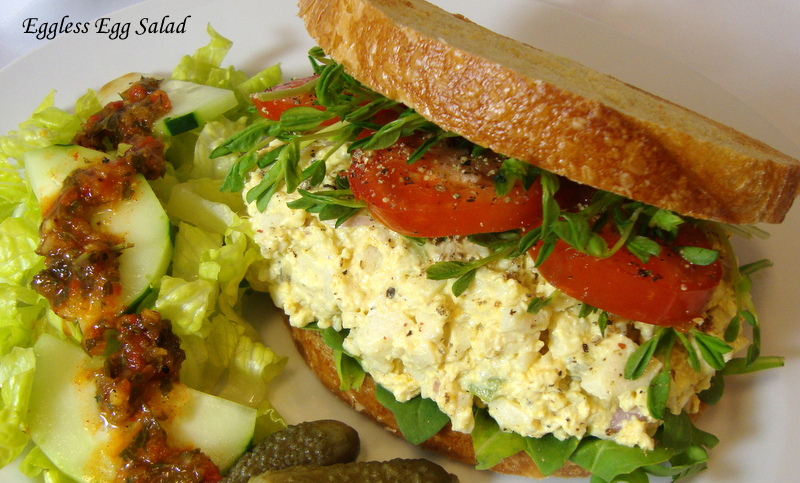 This tasty sandwich filling remarkably resembles real egg salad in appearance taste and texture, but without the cholesterol (or animal cruelty). A blender is required for preparing the “egg whites” and a food processor is recommended for the “yolk” mixture. You will also need 1 block (about 14 oz before pressing) extra-firm water-packed tofu (not silken tofu). Drain and press the tofu until it is not releasing any more liquid – this is very important! After pressing you should have approximately 12 ounces of tofu.
This tasty sandwich filling remarkably resembles real egg salad in appearance taste and texture, but without the cholesterol (or animal cruelty). A blender is required for preparing the “egg whites” and a food processor is recommended for the “yolk” mixture. You will also need 1 block (about 14 oz before pressing) extra-firm water-packed tofu (not silken tofu). Drain and press the tofu until it is not releasing any more liquid – this is very important! After pressing you should have approximately 12 ounces of tofu.
Ingredients for the “Egg Whites”
• ⅓ block (about 5 oz before pressing) extra-firm tofu (not silken tofu)
• ¾ tsp kala namak (Himalayan black salt)
• 2 cups water
• 2 and ¼ tsp agar powder
Ingredients for the “Yolk” Mixture
• ⅔ block (about 9 oz before pressing) extra-firm tofu (not silken tofu)
• ¼ cup eggless mayonnaise, plus additional as necessary for consistency
• 1 T nutritional yeast flakes
• 2 tsp prepared mustard, your choice of Dijon, spicy, golden or yellow
• ¼ tsp kala namak (Himalayan black salt), or more to taste
• ¼ tsp sweet paprika
• ¼ tsp ground turmeric
• 2 T minced shallot or red onion
• 1 rib of celery, diced
• coarse ground black pepper to taste
• optional ingredients sliced black olives, capers, or diced sweet or dill pickle
Preparation
Drain and press the tofu until it is not releasing any more liquid. Slice ⅓ of the tofu to use for the “egg whites. The remaining ⅔ will be used for the “yolk” filling.
To prepare the “egg whites”, place the “egg white” ingredients into a blender and process until smooth. Pour the mixture into a saucepan and bring to a simmer over medium heat, stirring frequently to avoid scorching the tofu mixture. Avoid boiling as this will cause the soy protein to re-coagulate (a minimal degree of re-coagulation may occur as the mixture is brought to a simmer but will not affect the final appearance or texture). Pour the mixture into the 8” baking pan and set aside to cool. After cooling a bit, refrigerate until completely set, about 1 hour.
Next, crumble the ⅔ pressed block of pressed tofu into a food processor and add the mayo, nutritional yeast flakes, prepared mustard, kala namak, turmeric and paprika. Process the contents until completely smooth, stopping as necessary to scrape down the sides of the food processor. Alternately, the mixture can be mashed using a fork but the mixture will not be as smooth.
Transfer the “yolk” mixture to a bowl or a food storage container and stir in the minced onion, celery, black pepper and any optional ingredients. Mix well, cover and refrigerate until ready to use.
Now, run a table knife around the perimeter of the “egg white” container to loosen if necessary and invert onto a work surface. Chop the “egg whites” into fine dice and transfer to a mixing bowl. Stir in the “yolk” mixture and add additional mayonnaise as necessary to thoroughly moisten the eggless salad. Season the mixture with additional salt and pepper as desired, cover with plastic wrap and chill thoroughly before serving.
Print Recipe
Eggless Egg Salad
Votes: 5
Rating: 5
You:
Rate this recipe!
|
|
Votes: 5
Rating: 5
You:
Rate this recipe!
|
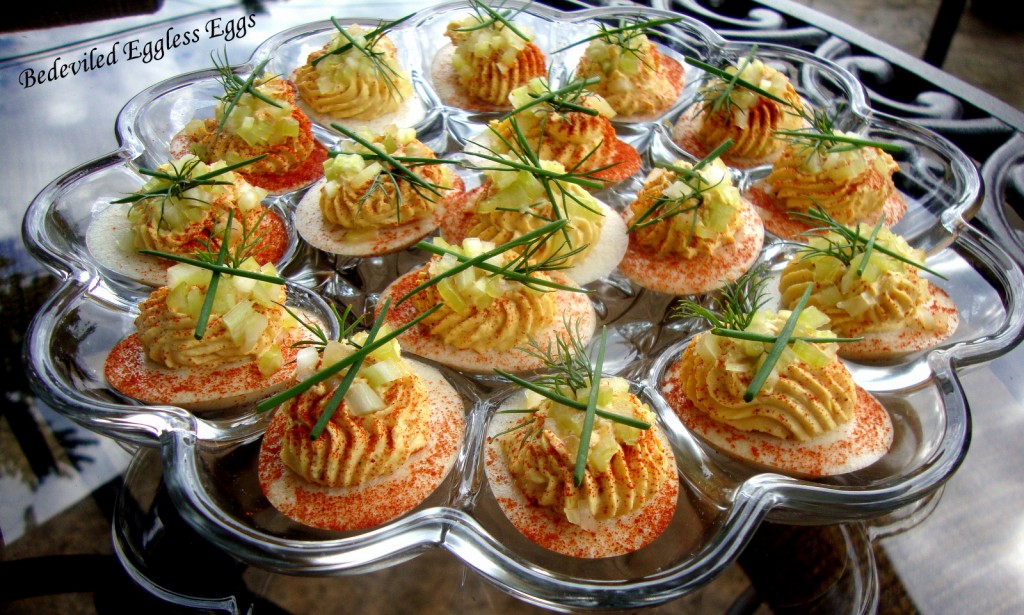 Bedeviled eggless eggs are remarkably similar to deviled eggs in appearance, taste and texture. They make the perfect bite-size finger food for BBQs, picnics and parties. Kala namak, or Himalayan black salt, is essential to impart that familiar egg-like taste to these savory bites.
Bedeviled eggless eggs are remarkably similar to deviled eggs in appearance, taste and texture. They make the perfect bite-size finger food for BBQs, picnics and parties. Kala namak, or Himalayan black salt, is essential to impart that familiar egg-like taste to these savory bites.
A blender is required for preparing the “egg whites” and a food processor is recommended for the “yolk filling”. You will also need an 8” square baking pan and 1 block (about 14 oz. before pressing) extra-firm water-packed tofu (not silken tofu). If you have egg molds, or a heat-proof container that specifically holds deviled eggs, the “egg white” mixture can be poured directly into the molds to create perfect, halved hard-boiled egg shapes. This recipe yields 16 to 24 bedeviled eggless eggs or more depending upon the mold(s) used for the “egg whites”.
Ingredients for the “Egg Whites”
• ⅓ block (about 5 oz before pressing) extra-firm tofu (not silken tofu)
• ¾ tsp kala namak (Himalayan black salt)
• 2 cups water
• 2 and ¼ tsp agar powder
Ingredients for the “Yolk” Filling
• ⅔ block (about 9 oz before pressing) extra-firm tofu (not silken tofu)
• ¼ cup eggless mayonnaise
• 1 T nutritional yeast flakes
• 1 T dill pickle brine
• 2 tsp Dijon mustard or spicy golden mustard
• ½ tsp onion powder
• ¼ tsp kala namak* (Himalayan black salt), or more to taste
• ¼ tsp sweet paprika (for extra “bedeviling” add a pinch of cayenne pepper too)
• ¼ tsp ground turmeric
Garnishes
• sweet paprika
• optional: coarse ground black pepper, sliced black olives; fresh snipped chives or “spears”; capers; minced celery; minced onion; chopped cornichons; chopped dill or dill “fronds”
Preparation
Drain and press the tofu until it is not releasing any more liquid. Slice ⅓ of the tofu to use for the “egg whites”. The remaining ⅔ will be used for the “yolk” filling.
To prepare the “egg whites”, place the “egg white” ingredients into a blender and process until smooth. Pour the mixture into a saucepan and bring to a simmer over medium heat, stirring frequently to avoid scorching the tofu mixture. Avoid boiling as this will cause the soy protein to re-coagulate (a minimal degree of re-coagulation may occur as the mixture is brought to a simmer but will not affect the final appearance or texture). Pour the mixture into the 8” baking pan and set aside to cool. If you have egg molds, or a heat-proof container that specifically holds deviled eggs, pour the tofu mixture directly into the molds and set aside to cool. After cooling a bit, refrigerate until completely set, about 1 hour.
Next, crumble the ⅔ block of pressed tofu into the food processor and add the remaining “yolk” filling ingredients. Process the contents until completely smooth, stopping as necessary to scrape down the sides of the food processor. Alternately, the mixture can be mashed using a fork or a potato masher/ricer, but the mixture will not be as smooth. Taste the mixture and add additional kala namak (or sea salt) as desired.
Transfer the “yolk” mixture to a bowl or food storage container, cover and refrigerate until ready to use.
Now, run a table knife around the perimeter of the baking pan to loosen the “egg white” (or simply pop them out of the egg molds). Invert the baking pan onto a clean work surface. At this point, the “egg white” can be cut into rectangles or cut into rounds or ovals.
For rectangles, cut the “egg whites” into 6 even strips. Turn your cutting surface and make 4 even slices. This will create 24 rectangles. For rounds or ovals, use a 1 and ½-inch to 1 and ¾-inch cookie cutter or ring mold. Any “egg white” remnants can be finely diced and mixed with any of the leftover “yolk” filling for a quick eggless egg salad sandwich.
Spoon a generous teaspoonful of the “yolk” mixture onto the top of each “egg white”. Alternately, the mixture can be decoratively piped onto the “egg whites” using a pastry bag. If you don’t have a pastry bag, try placing the mixture into a zip-lock bag, seal and then snip off a tiny piece from the bottom corner of the bag with scissors. Squeeze the bag to pipe the mixture onto the “egg whites”.
Sprinkle with paprika and garnish with optional ingredients as desired. Cover gently with plastic wrap and chill thoroughly before serving.
Print Recipe
Bedeviled Eggless Eggs
Votes: 19
Rating: 4.53
You:
Rate this recipe!
|
|
Votes: 19
Rating: 4.53
You:
Rate this recipe!
|
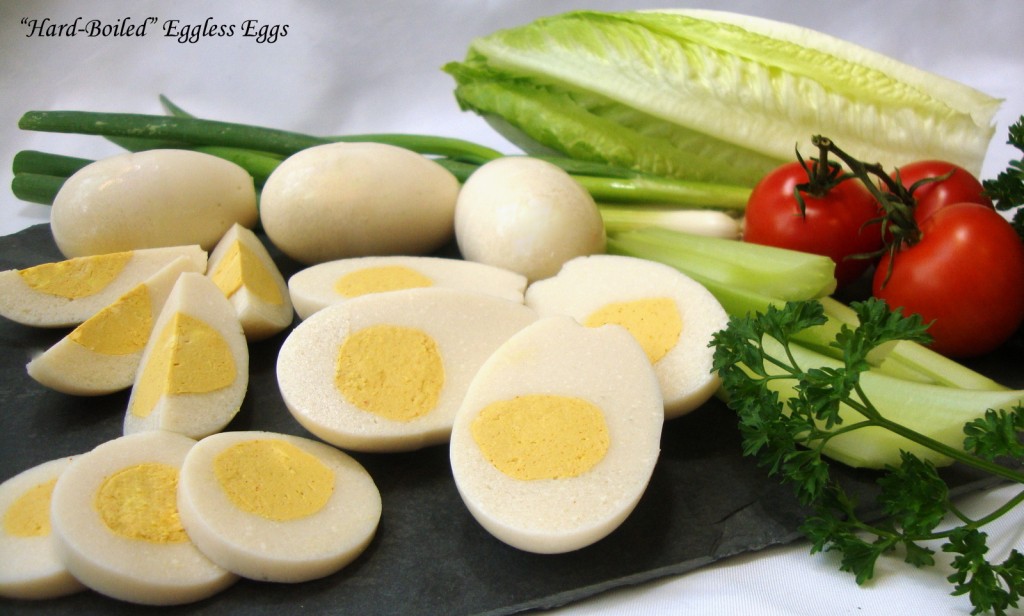 Important! This recipe should only be used if you wish to prepare solid “hard-cooked” eggless eggs. If you wish to prepare vegan deviled “eggs” or eggless “egg” salad, please see the appropriate recipe in this blog or in my Non-Dairy Evolution Cookbook, as these recipes are much less involved and easier to prepare.
Important! This recipe should only be used if you wish to prepare solid “hard-cooked” eggless eggs. If you wish to prepare vegan deviled “eggs” or eggless “egg” salad, please see the appropriate recipe in this blog or in my Non-Dairy Evolution Cookbook, as these recipes are much less involved and easier to prepare.
This is my own recipe and technique for producing “hard-cooked” eggless eggs that are remarkably similar to their egg counterparts in appearance, flavor and texture. For this recipe, you will need 2 six-count egg molds which will yield one dozen “hard-cooked” eggless eggs. If you only have one mold set, any remaining “yolk” and “egg white” mixture” can be used for crumbled “hard-cooked” eggless egg (superb for topping cold salads) or for eggless egg salad sandwiches.
Please note: The “eggs” cannot be used for heated applications, such as “Scotch eggs”, because the agar will melt and the eggs will turn to mush. They must remain chilled or at room temperature for serving.
About the egg molds: The internet source I was recommending for the egg molds is no longer offering that product, so you will have to do some internet searching for the molds. Many of my readers have found luck locating them on Ebay.com (search for “Jell-O jiggler egg molds”).
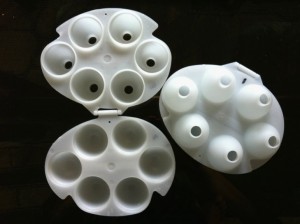
Food Processor Ingredients for the “Egg Yolks”
• 5 oz pressed extra-firm block tofu (about one-half of a standard block; do not use silken tofu)
• 2 T refined coconut oil, melted
• 2 T nutritional yeast flakes
• ¼ tsp sodium alginate, guar gum or xanthan gum
Saucepan Ingredients for the “Egg Yolks”
• ½ cup water
• 1 and ½ tsp agar powder
• ½ tsp sweet paprika
• ½ tsp ground turmeric
• ¼ tsp kala namak (Himalayan black salt)
Blender Ingredients for the “Egg Whites”
• 5 oz pressed extra-firm block tofu (about one-half of a standard block; do not use silken tofu)
• 3 cups water
• ½ cup plain unsweetened non-dairy milk
• 4 tsp agar powder
• 1 and ¼ tsp kala namak (Himalayan black salt)
Additional Items Needed
• 2 six-count egg molds
• food processor
• blender
• small saucepan
• a melon baller or ½ T measuring spoon
• small food storage container that will hold about 2 cups
• 2 cup measuring cup with pouring lip
• wax paper or parchment paper
Preparing the “Yolks”
Set the “egg molds” aside. Be sure they are completely snapped together.
Place the food processor ingredients for the “yolks” into a food processor; process into a coarse paste.
Combine the saucepan ingredients for the “yolks” in the saucepan and heat until bubbly over medium heat. Swirl the contents occasionally as the mixture heats.
With the food processor running, pour the molten saucepan mixture into the food chute. Process the entire contents until smooth. Stop as needed to scrape down the sides with a flexible spatula.
Transfer the “yolk” mixture to the food storage container and chill uncovered for a minimum of 1 hour to firm.
Line a plate with wax or parchment paper. Using a melon baller, rounded measuring spoon or similar object, scoop some of the “yolk” mixture into a rough ball shape, about the size of a hardened egg yolk. Roll the mixture between your palms to round the ball and smooth the surface a bit. It doesn’t have to be totally smooth. Set it on the lined plate. Repeat the procedure until you have 12 “yolks”. Make sure the “yolks” are not touching each other on the plate or they will stick together when frozen. This procedure is a bit messy and some of the mixture will stick to your hands, so keep a moist towel nearby. Place the uncovered plate into the freezer for about 1 hour. Avoid freezing for more than 2 hours or ice crystals will form on the “yolks”.
Preparing the “Egg Whites”
When ready to proceed, add the blender ingredients for the “egg whites” to a blender and process until completely liquefied. Add half of the mixture to the saucepan and heat to a soft boil, stirring frequently to avoid scorching. Transfer the hot mixture to the measuring cup with the lip. The mixture may begin to curdle a bit in the measuring cup – this is normal and will not affect the finished flavor or texture. Pour the mixture into the molds, filling them no more than halfway. Let cool at room temperature for 10 minutes to help set the “white” mixture just a bit (this will help keep the yolk suspended, rather than sinking).
Carefully open the molds and place the frozen “yolks” in the center of each “white”. Close the molds and securely snap shut. Make sure they are completely snapped shut or the molten “white” mixture will leak out when topping off.
Pour the remaining “egg white” mixture into the saucepan and bring to a soft boil, stirring frequently. Transfer the mixture to the measuring cup and then fill each egg mold with the mixture to the top of the stems. The mixture may begin to curdle a bit in the measuring cup – this is normal and will not affect the finished flavor or texture. Let settle momentarily and then top off each mold with the mixture (the excess “whites” in the stems can be trimmed away later).
Transfer the molds to the refrigerator and chill for a few hours until completely set. Be careful handling the molds when transferring to the refrigerator so they do not pop open accidentally (for assurance, place the molds on a tray and then transfer to the refrigerator).
Finishing the “Hard-Boiled Eggs”
Open the molds and pop out the “eggs”. There will be a seam on the “eggs” where the molds joined together. Use a dry paper towel to gently rub the “egg” and remove the seam. Trim off the stem ends as needed with a paring knife. Chill the “eggs” in an airtight container until ready to use. The “eggs” should be consumed within 1 week. I’ve never frozen them for storage, so I cannot advise if this can be done successfully without damaging the texture.

Print Recipe
“Hard-Cooked” Eggless Eggs
Votes: 56
Rating: 3.88
You:
Rate this recipe!
|
|
Votes: 56
Rating: 3.88
You:
Rate this recipe!
|














